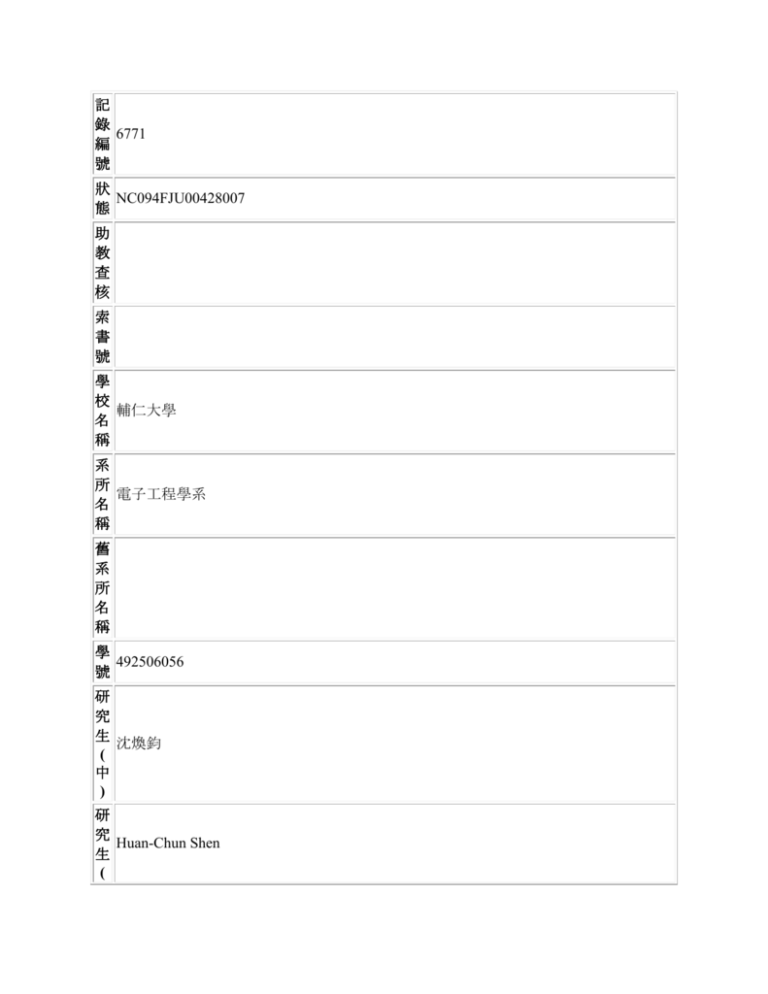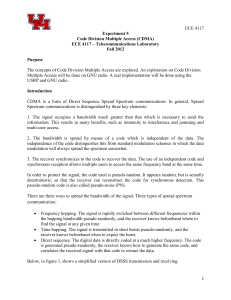記錄編號 6771 狀態 NC094FJU00428007 助教查核 索書號 學校名稱
advertisement

記 錄 6771 編 號 狀 NC094FJU00428007 態 助 教 查 核 索 書 號 學 校 輔仁大學 名 稱 系 所 電子工程學系 名 稱 舊 系 所 名 稱 學 492506056 號 研 究 生 沈煥鈞 ( 中 ) 研 究 Huan-Chun Shen 生 ( 英 ) 論 文 名 稱 新群體盲目多使用者偵測器在多通道路徑的直接序列分碼多重接取系統 ( 中 ) 論 文 名 稱 A Novel Group Blind Multiuser Detection for DS-CDMA Systems with Multipaths ( 英 ) 其 他 題 名 指 導 教 授 余金郎 ( 中 ) 指 導 教 授 Jung-Lang Yu ( 英 ) 校 內 全 文 開 放 日 期 校 外 全 文 開 放 日 期 全 文 不 開 放 理 由 電 子 全 文 送 交 國 圖 . 國 圖 全 文 開 放 日 期 . 檔 案 說 明 電 子 全 文 學 位 碩士 類 別 畢 業 學 94 年 度 出 版 年 語 文 英文 別 關 鍵 字 群體 偵測器 偵側器 複雜度 使用者 缺點 直接序列分碼多重接取 CDMA ( 中 ) 關 鍵 字 Group DS-CDMA Group Blind Multiuser Detection ( 英 ) 摘 要 ( 中 ) 第三代行動通訊立基於分碼多工存取(CDMA)的系統上,因為CDMA的系統可以提供 比分時多工存取(TDMA)和分頻多工存取(FDMA)較好的能力。但在CDMA的系統中 虛擬序列不能完全的有正交特性在多路逕的環境底下,訊號在接收端就很難被偵測出 來。傳統盲目估測的偵側器藉由已知需被偵測出使用者的展頻序列而發展出來的。如 果接收端已經知道群體使用者的展頻序列,相對應的矩正將可以被估測出來而且群體 盲目偵測器可以立用額外的群體的限制被發展出。群體盲目多使用者偵測器已經發展 在上傳和下傳的CDMA系統. 最早的群體盲目偵測器利用群體限制發展出,但這樣的 群體限制只能利用已知群體使用者的展頻序列和相關向量而取得。由此缺點,改進的 群體盲目線性偵測器利用訊號之間的相關訊息去產生群體限制而且只要使用需被偵測 出使用者的相關向量。 在這篇論文,我們發現這個改進過的限制有些矛盾在取樣的情 形下。而且強化後的限制為了改善性能被發表出。考慮到實際的操作上,強化偵測器 的複雜度可以利用轉換線性偵測器被減少而且也簡化了接收端的偵測器。模擬結果會 證明強化偵測器和轉換偵測器比之前的偵測器有更好的性能。 摘 要 ( 英 ) The 3rd generation mobile communication will base on code-division multiple-access (CDMA) system, because CDMA systems can provide more capacity than time-division multiple access (TDMA) and frequency-division multiple access (FDMA). But in CDMA systems the pseudo-noise sequences are not exactly orthogonal in multipath environments; signals can not be detected in the receiver. The conventional blind mutiuser detectors are developed by only knowing the spreading sequence of the desired user. If the receiver has known the spreading sequences of a group of users, the corresponding signature matrix can be estimated and the group-blind detectors can be developed by using additional group constraints. Group Blind mutiuser detectors had been developed in uplink and downlink CDMA systems. The first group blind detectors are developed by adding the group constraints, but these group constraints are derived only if the spreading sequences and thus the signature vectors of a group of users are known. In light of this disadvantage, an improved group-blind linear detector use the correlation information between consecutively received signals to generate the corresponding group constraint and only use the signature vectors of the desired user. In this paper, we find the contradiction of these improved constraints in the finite sample scenario .Then the enhanced constraints were proposed for improving performance gain, and construct enhanced detectors. Considering the real-time implementation, the computational complexity of the enhanced detectors can be reduced by using a transformation-based linear detector and simplify the detectors in the receiver. Simulation results demonstrate Enhanced detectors and transformation detectors have better performance. 論 文 目 次 Contents Abstract ( in Chinese)…………………………………………………………i Abstract ………………………………………………………………………………ii Acknowledgement……………………………………………………………………iii Contents……………………………………………………………………………………iv List of figures…………………………………………………………………………vi 1. Introduction…………………………………………………………1 1.1 Multiple Access Techniques…………………………………………………1 1.2 Overview of CDMA…………………………………………………………2 1.3 A Motive of Research………………………………………………………3 1.4 Group-Blind Multiuser Detection……………………………………………4 1.5 Outline of Thesis……………………………………………………………5 2. Basic Fundamentals………………………………………………………7 2.1 Basic Fundament of DS-CDMA……………………………………………7 2.2 A Cellular CDMA system………………………………………………10 2.3 The MAI and Near Far Problem……………………………………………12 3. Review of group-blind multiuser detectors and blind channel Estimation……………………………………14 3.1 Review of Group-Blind Multiuser Detectors and Conventional Blind Linear Detectors…………………………………………………………………14 3.2 Subspacebased channel estimation…………………………………19 4. Enhanced Group Blind Multiuser Detectors, Transformation Multiuser Detectors, and Enhanced Blind Channel Estimation.........................................................22 4.1 Discussion of Group Constraints……………………………………22 4.2 Enhanced Group Blind Multiuser Detectors……26 4.3 Transformation of Group Blind Multiuser Detectors……………30 4.4 Simulation Resulat…………………………………………………………4 5. Conclusions………………………………………………………54 5.1 Summary……………………………………………………………………54 5.2 Future Work………………………………………………………………54 Appendix A……………………………………………………………56 Appendix B……………………………………………………………57 References……………………………………………………………58 List of Figures Figure Page Fig. 1.1: FDMA TDMA and CDMA……………………………………………2 Fig. 2.1: Downlink CDMA System………………………………………………11 Fig. 2.2: Uplink CDMA System……………………………………………………12 Fig. 2.3: Near-Far Effect……………………………………………………………13 Fig. 4.1: RMSE of channel estimation for asynchronous CDMA when the number multipath delays varies from 1 to 16..…………….....................................40 Fig.4.2 RMSE of channel estimation for asynchronous CDMA when the input SNR varies from -5dB to 14dB…………………………………………………41 Fig.4.3 BER comparison of different detectors for asynchronous CDMA when the input SNR varies from -5dB to 14dB (7 asynchronous intracell users)……………………………………………………………………42 Fig. 4.4 BER comparison of different detectors for asynchronous CDMA when the input SNR varies from -5dB to 14dB (8 asynchronous intracell users and 2 asynchronous users)………………………………………………………43 Fig. 4.5 BER comparison of different detectors for asynchronous CDMA when the input SNR varies from -5dB to 14dB (8 asynchronous intracell users and 7 asynchronous users).………………………………………………………44 Fig. 4.6 BER comparison of different detectors for synchronous CDMA when the input SNR varies from -5dB to 14dB. (8 synchronous intracell users and 2 asynchronous users)………………………………………………………45 Fig. 4.7 BER comparison of different detectors for synchronous CDMA when the input SNR varies from -5dB to 14dB. (8 synchronous intracell users and 7 asynchronous users)………………………………………………………46 Fig. 4.8 There are fixed 1 intercell users, and variable intracell users from 1 to 14. BER comparison is in uplink SNR=3 dB…………………………………47 Fig. 4.9 There are fixed 1 intercell users, and variable intracell users from 1 to 14. BER comparison is in downlink SNR=6 dB………………………………48 Fig. 4.10 BERs versus data block size. SNR=5 dB Block size are from 100 to 5 000 in uplink. (8 asynchronous intracell users and 7 asynchronous users)………49 Fig. 4.11 BERs versus data block size. SNR=5dB Block size are from 100 to 5000 in downlink. (8 synchronous intracell users and 7 asynchronous users)……50 Fig. 4.12 BERs versus the rank of . SNR=3 dB the rank of are from 0 to 31 in uplink (8 asynchronous intracell users and 2 asynchronous users)………51 Fig. 4.13 BERs versus the rank of . SNR=6 dB the rank of are from 0 to 31 in downlink (8 synchronous intracell users and 2 asynchronous users)……52 參 考 文 獻 REFERENCES [1] R. Steele and L. Hanzo, Mobile Radio Communication. IEEE PressJohn Wiley, second ed. 1999. [2] M. K. Simon, J. K. Omura, R. A. Scholtz, and B. K. Levitt, Spread Spectrum Communications Handbook. McGraw Hill, 1994. [3] A. J. Viterbi, CDMA: Principles of Spread Spectrum Communication. Addison-Wesley Publishing Company, 1995. [4] L. E. Miller and J. S. Lee, CDMA systems Engineering Handbook. Boston: Artech House, 1998. [5] J. S. Lee, “Overview of the technical basis of QUALCOMM’s CDMA cellular telephone system design: A view of North American TIA/EIA IS-95,” in International Conference on Communications Systems (ICCS), 1997. [6]. J. Viterbi, CDMA: Principles of Spread Spectrum Communications. Reading, MA: Addison-Wesley, 1995. [7]. S. Verdu, Mutiuser Dectection. Cambridge, U.K.: Cambridge Univ. Press, 1998. [8]. S. Moshavi, “Multiuser detection for DS-CDMA communications,” IEEE Commun. Mag., vol. 34, pp. 124-136, Oct. 1996. [9]. Duel-Hallen, J. Holtzman, and Z. Zvonar, “Multiuser detection for CDMA systems,” IEEE Trans. Commun., vol. 2, pp. 46-58, Apr. 1995. [10]. U. Mitra and H. V. Poor, “adaptivr multiuser receiver algorithms for CDMA system,” IEEE Trans. Commun., vol. 41, no. 11, pp. 1375-1378, Nov. 1997. [11]. G.L. Stuber and M.D. Austin and E. Katz, “MMSE sequences for channel estimation,” IEEE Trans. Commun., vol. 30, pp. 2106 – 2107, Dec. 1994. [12]. M. Honig, U. Madhow, and S. Verdu, “Blind adaptive multiuser detection,” IEEE Trans. Inform. Theory, vol. 41, pp. 944-960, July 1995. [13]. X. Wang and H. V. Poor, “Blind mutiuser detection: A subspace approach,” IEEE Trans. Inform. Theory, vol. 44, no. 2, pp. 677-691, Mar. 1998. [14]. U. Madhow, “Blind adaptive interference for direct sequence CDMA,” IEEE Trans. Commun., vol. 86, pp. 2049-2069, Oct. 1998. [15]. J. B. Schodorf and D. B. Williams, “Array processing techniques for multiuser detection,” IEEEE Trans. Commun., vol. 41, no. 11, pp. 1375-1378, Nov. 1997. [16]. Yu Qian, Zhang Gaonan and Bi. Guoan, “Improved blind channel estimation method with Toeplitz displacement for long code DS-CDMA,” IEEE Trans. Commun., pp. 224 – 228, June 2003. [17]. M. K. Tsatsanis and Z. Xu, “Performance analysis of minimum variance CDMA receivers,” IEEE Trans, Signal Process, vol. 46, no. 11, pp. 3014-3022, Nov. 1998. [18]. Z. Xu and M. K. Tsatsanis, “Blind adaptive algorithms for minimum variance CDMA receivers,” IEEE Trans. Commun., vol. 49, no. 1, pp. 180-194, Jan. 2001. [19]. X. Wang and A. Host-Madsen, “Group-blind multiuser detection for uplink CDMA,” IEEE, J. Sel. Areas Commun., vol. 17, no. 11, pp. 1971-1984, Nov. 1999. [20]. D. Reynolds and X. Wang, “Adaptive group-blind multiuser detection based on a new subspace tracking algorithm,” IEEE Trans. Commun., vol. 49, pp. 1135 – 1141, July 2001. [21]. Z. Gaonan, Bi. Guoan, and Z. Liren, “Group-blind intersymbol multiuser detection for downlink CDMA with multipath,” IEEE Trans. Commun., vol. 4, pp. 434 – 443, March 2005. [22]. H. Li, X. Lu and G.B. Giannakis, “Capon multiuser receiver for CDMA systems with space-time coding,” IEEE Trans. Signal Process., vol. 50, Issue 5, pp. 1193 – 1204, May 2002. [23]. Z. Shengli, and G.B. Giannakis, “Finite-alphabet based channel estimation for OFDM and related multicarrier systems,” IEEE Trans. Signal Process, vol. 49, Issue 8, pp. 1402 – 1414, Aug. 2003. [24]. E. Aktas and U. Mitra, “Complexity Reduction in Subspace-Based Blind Channel Identification for DS/CDMA Systems,” IEEE Trans. Commun., vol. 48 No.8, pp. 1392-1404, Aug. 2000. [25]. J.L. Yu and M.L. Leou, “Transformation-based adaptive array beamforming,” IEEE Trans. Signal Process, vol. 80, pp. 231-241, Nov. 1998. 論 文 70 頁 數 附 註 全 文 點 閱 次 數 資 料 建 置 時 間 轉 檔 日 期 全 文 檔 存 取 記 錄 異 動 M admin Y2008.M7.D3 23:18 61.59.161.35 記 錄








